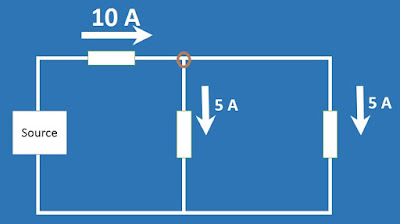OR
The sum of all currents entering any point is equal to sum of all currents leaving that point.
Kirchhoff Current law is fundamental law of Electric Circuits which explains an equal relationship between amount of Current that enters and exits through any specific point.
Now let’s take an example of understanding the concept of Kirchhoff current law.
Consider the point marked with circle in the figure, the point is acting as ‘node’. Remember that ‘node’ is the point, where two or more than two wires meet.
Now we will apply KCL to node. The total amount of current entering on the node is 10 A, According to KCL the ‘Current IN’ in present case is 10 A. While the current leaving the node is 5+5 Amp which makes 10 A in total.
Mathematically if we apply KCL on that point, then
∑ Current IN = ∑ Current Out
10 A = 5 A + 5 A
10 A= 10 A
Which verifies KCL
Now lets take another example understand KCL in easy way.
In diagram there are 6 value of Current. I 1, I 2, I 3 , I 4, I 5 and I 6. In case we have to find two values I 5 and I 6. Two nodes shown with red and yellow color are present. Red node has one unknown current I 5 flowing away from the node, where yellow node has two unknown currents I 5 and I 6.
While solving problem, remember to start from Node which has lowest number of unknown values. Now, on red node, first calculate total amount of currents flowing to point. In this I 1 = 20 A is flowing towards the point. Whereas I 2, I 3, I 4 and I 5 are flowing away from the node.
Apply mathematical equation.
∑Current IN= ∑Current Out
I 1 = I 2 + I 3 + I 4 + I 5
20 A = 15 A + 3 A + 1 A + I 5
20 A – 15 A – 3 A – 1 A = I 5
1 A = I 5
So value of I 5 is 1 A
To find value of current on point I 6 again apply KCL on yellow node.
∑Current IN= ∑Current Out
I 4 + I 5 = I 6
1 A + 1 A = I 6
2 A = I 6
or I 6 = 2 A



